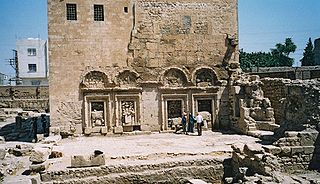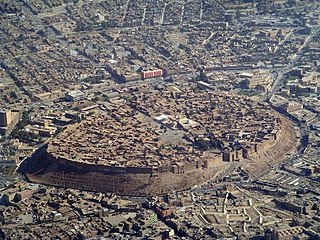Related Research Articles

At the height of its power, in the 10th century AD, the dioceses of the Church of the East numbered well over a hundred and stretched from Egypt to China. These dioceses were organised into six interior provinces in Mesopotamia, in the Church's Iraqi heartland, and a dozen or more second-rank exterior provinces. Most of the exterior provinces were located in Iran, Central Asia, India and China, testifying to the Church's remarkable eastern expansion in the Middle Ages. A number of East Syriac dioceses were also established in the towns of the eastern Mediterranean, in Palestine, Syria, Cilicia and Egypt.

The Metropolitanate of Nisibis was an East Syriac metropolitan province of the Church of the East, between the fifth and seventeenth centuries. The ecclesiastical province of Nisibis had a number of suffragan dioceses at different periods in its history, including Arzun, Beth Rahimaï, Beth Qardu, Beth Zabdaï, Qube d’Arzun, Balad, Shigar (Sinjar), Armenia, Beth Tabyathe and the Kartawaye, Harran and Callinicus (Raqqa), Maiperqat, Reshʿaïna, Qarta and Adarma, Qaimar and Hesna d'Kifa. Aoustan d'Arzun and Beth Moksaye were also suffragan dioceses in the fifth century.

Metropolitanate of Adiabene was an East Syriac metropolitan province of the Church of the East between the 5th and 14th centuries, with more than fifteen known suffragan dioceses at different periods in its history. Although the name Hadyab normally connoted the region around Erbil and Mosul in present-day Iraq, the boundaries of the East Syriac metropolitan province went well beyond the Erbil and Mosul districts. Its known suffragan dioceses included Beth Bgash and Adarbaigan, well to the east of Adiabene proper.

Dioceses of the Syriac Orthodox Church: In the period of its greatest expansion, in the tenth century, the Syriac Orthodox Church had around 20 metropolitan dioceses and a little over a hundred suffragan dioceses. By the seventeenth century only 20 dioceses remained, reduced in the twentieth century to 10. The seat of Syriac Orthodox Patriarch of Antioch was at Mardin before the First World War, and thereafter in Deir Zaʿfaran, from 1932 in Homs, and finally from 1959 in Damascus.
The Diocese of Tirhan was an East Syriac diocese of the Church of the East, within the central ecclesiastical Province of the Patriarch. The diocese is attested between the sixth and fourteenth centuries.
Yohannan V was Patriarch of the Church of the East from 1000 to 1011.
Denha II was patriarch of the Church of the East from 1336/7 to 1381/2. Although no history of his reign has survived, references in a number of Nestorian, Jacobite and Moslem sources provide some details of his patriarchate.
Hadath was a diocese of the Syriac Orthodox Church in the Malatya region of what is now Turkey, attested between the eighth and eleventh centuries. It was based in the town of Hadath.
Gubos was a diocese in the Syriac Orthodox metropolitan province of Melitene (Malatya), attested between the ninth and thirteenth centuries. Around a dozen Jacobite bishops of Gubos are mentioned either by Michael the Syrian or Bar Hebraeus, and Bar Hebraeus himself was bishop of Gubos from 1246 to 1255. By 1283, as a result of several decades of warfare and brigandage, the diocese of Gubos was ruined. It is not again mentioned, and seems to have lapsed before the end of the thirteenth century.
Zuptara was a Syriac Orthodox diocese in the Melitene region of eastern Turkey. The diocese of Zuptara is attested between the eighth and eleventh centuries, and twelve of its bishops are mentioned in the lists of Michael the Syrian. The diocese almost certainly lapsed during the twelfth century.
Qlisura was a diocese in the Syriac Orthodox metropolitan province of Melitene, attested between the ninth and thirteenth centuries. Eighteen Jacobite bishops of Qlisura are mentioned in the histories of Michael the Syrian and Bar Hebraeus, and in other West Syriac sources. By 1283, as a result of several decades of warfare and brigandage, the diocese of Qlisura was ruined, though it apparently still had a bishop several years later. The diocese is not again mentioned, and seems to have lapsed around the end of the thirteenth century.
Qlaudia was a diocese in the Syriac Orthodox metropolitan province of Melitene (Malatya), attested between the tenth and thirteenth centuries. Sixteen Jacobite bishops of Qlaudia are mentioned either by Michael the Syrian or Bar Hebraeus. By 1283, as a result of several decades of warfare and brigandage, the diocese of Qlaudia was ruined. The diocese is not again mentioned, and seems to have lapsed around the end of the thirteenth century.
The city of Anazarbus was an archdiocese of the Syriac Orthodox Church, attested between the sixth and twelfth centuries. Nearly thirty Syriac Orthodox bishops or metropolitans of Anazarbus are mentioned either by Michael the Syrian or in other Syriac Orthodox narrative sources. The archdiocese is last mentioned towards the end of the twelfth century, and seems to have lapsed in the early decades of the thirteenth century.
Tel Patriq was a diocese of the Syriac Orthodox Church near Melitene (Malatya), attested during the eleventh and twelfth centuries.
Laqabin was a diocese of the Syriac Orthodox Church, suffragan of the archdiocese of Melitene. The diocese, also known as Qarna and Tella d'Arsenias, is attested between the tenth and thirteenth centuries. Twenty-three bishops of Laqabin are mentioned in the histories of Michael the Syrian and Bar Hebraeus and in other West Syriac sources. The last-known bishop of Laqabin, Timothy, was consecrated by the patriarch Philoxenus Nemrud (1283–92), and the diocese seems to have lapsed in the early decades of the fourteenth century.
The city of Melitene was an archdiocese of the Syriac Orthodox Church, attested between the ninth and thirteenth centuries but probably founded as early as the seventh century. More than thirty Syriac Orthodox bishops or metropolitans of Melitene are mentioned either by Michael the Syrian or in other Syriac Orthodox narrative sources. The archdiocese is last mentioned towards the end of the twelfth century, and seems to have lapsed in the early decades of the thirteenth century.
Simandu was an archdiocese of the Syriac Orthodox Church in Cappadocia, attested between the tenth and twelfth centuries. Thirteen of its bishops are mentioned in the lists of Michael the Syriac and other Jacobite sources.

Kfar Tab was a diocese of the Syriac Orthodox Church near Apamea in Syria, attested in the eleventh and twelfth centuries. Four of its bishops are mentioned in the lists of Michael the Syrian.
Syriac Orthodox Archdiocese of Baghdad is an archdiocese of the Syriac Orthodox Church, centered in Baghdad, capital city of Iraq. The diocese originated during the early medieval period. It is attested between the 9th and the 13th centuries, but later declined, to be renewed again, thus existing up to the modern times. The diocese was probably established soon after Baghdad became the capital of the Abbasid Caliphate in the 770s. Eight Syriac Orthodox bishops of Baghdad from the medieval period are mentioned in the narratives of Michael the Syrian, Bar Hebraeus and other sources. Current Archbishop is Severius Jamil Hawa.
Gumal was a diocese of the Syriac Orthodox Church. Bishops of Gumal are attested between the sixth and tenth centuries, but the diocese may have persisted into the thirteenth century.
References
- Abbeloos, Jean Baptiste; Lamy, Thomas Joseph, eds. (1877). Bar Hebraeus, Chronicon Ecclesiasticum (3 vols). Paris.
- Fiey, Jean Maurice (1993). Pour un Oriens Christianus Novus: Répertoire des diocèses syriaques orientaux et occidentaux. Beirut: Orient-Institut. ISBN 9783515057189.
- Jean-Baptiste Chabot, Chronique de Michel le Syrien, Patriarche Jacobite d'Antiche (1166-1199). Éditée pour la première fois et traduite en francais I-IV (1899;1901;1905;1910; a supplement to volume I containing an introduction to Michael and his work, corrections, and an index, was published in 1924. Reprinted in four volumes 1963, 2010).